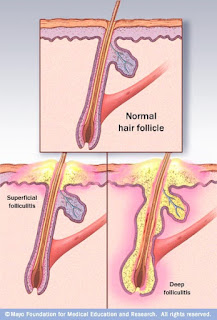Causes Of Hair Loss
Causes of Hair Loss
Androgenetic alopecia, a type of hair loss commonly called male or female pattern baldness, was only partially understood until the last few decades. For many years, scientists thought that androgenetic alopecia was caused by the predominance of the male sex hormone, testosterone, which women also have in trace amounts under normal conditions. But while testosterone is at the core of the balding process, dihydrotestosterone (DHT) is now thought to be the main culprit.
DHT, a derivative of the male hormone testosterone, is the enemy of hair follicles on your head. Simply put, under certain conditions DHT wants those follicles dead. This simple action is at the root of many kinds of hair loss.
Testosterone converts to DHT with the aid of the enzyme 5-alpha reductase. Scientists now believe that it's not the amount of circulating testosterone that's the problem but the level of DHT binding to receptors in scalp follicles. DHT shrinks hair follicles, making it impossible for healthy hair to survive.
The hormonal process of testosterone converting to DHT, which then harms hair follicles, happens in both men and women. Under normal conditions, women have a minute fraction of the level of testosterone that men have, but even a lower level can cause DHT- triggered hair loss in women.
Certainly when those testosterone levels rise, DHT is even more of a problem. DHT levels can be elevated and be within what doctors consider "normal range" on a blood test, but they may be high enough to cause a problem. The levels may not rise at all and still be a problem if you have the kind of body chemistry that is overly sensitive to even regular levels of chemicals, including hormones.
To decrease DHT use Monat hair treatment. silkysofthair.com
Certainly when those testosterone levels rise, DHT is even more of a problem. DHT levels can be elevated and be within what doctors consider "normal range" on a blood test, but they may be high enough to cause a problem. The levels may not rise at all and still be a problem if you have the kind of body chemistry that is overly sensitive to even regular levels of chemicals, including hormones.
To decrease DHT use Monat hair treatment. silkysofthair.com
Since hormones operate best when they are in a delicate balance, the androgens, as male hormones are called, do not need to be raised to trigger a problem. Their counterpart female hormones, when lowered, give an edge to these androgens, such as DHT. Such an imbalance can also cause problems, including hair loss.
Hair loss can also be caused by an imbalance of thyroid hormones or pregnancy, disease, and certain medications, which can all influence hair's growth and shedding phases.
Hormones are cyclical. Testosterone levels in some men drop by 10% each decade after age 30. Women's hormone levels decline as menopause approaches and drop sharply during menopause and beyond. The cyclic nature of both our hair and hormones is one reason hair loss can increase in the short term even when you are having a long-term slowdown of hair loss (and a long-term increase in hair growth) while on a treatment that controls hair loss.
Monat Hair Care Treatment can help decrease the DHT Hormone by 48% silkysofthair.com
Monat Hair Care Treatment can help decrease the DHT Hormone by 48% silkysofthair.com




Comments
Post a Comment